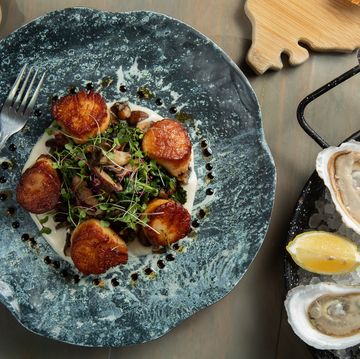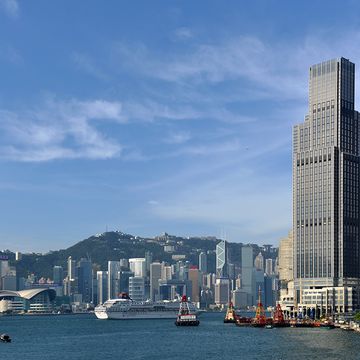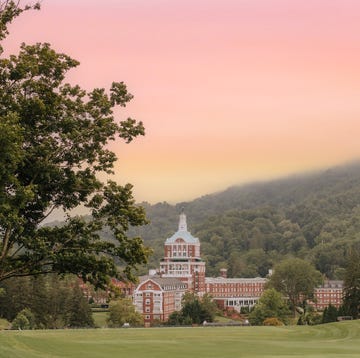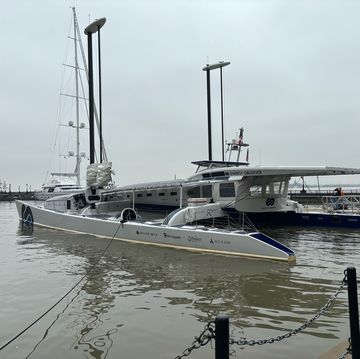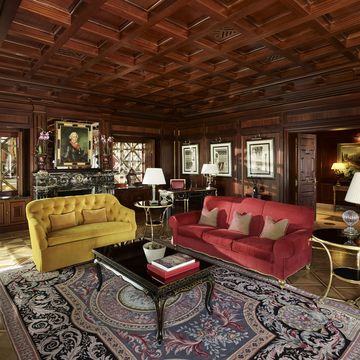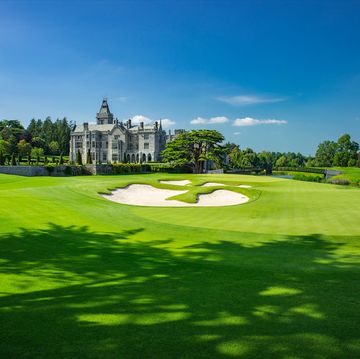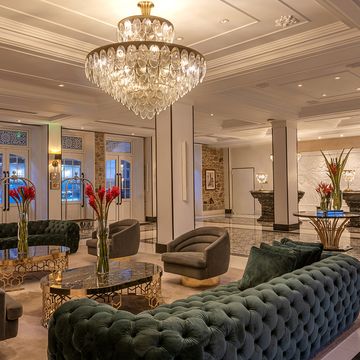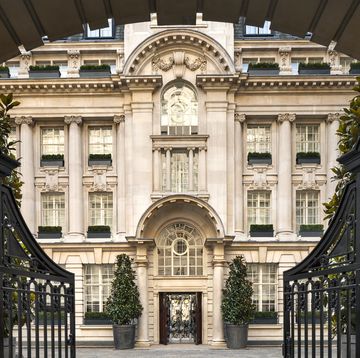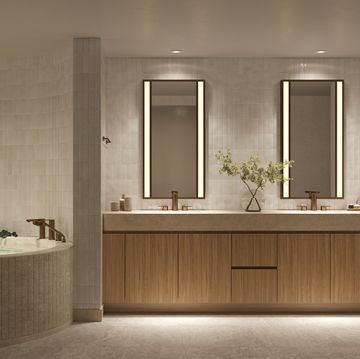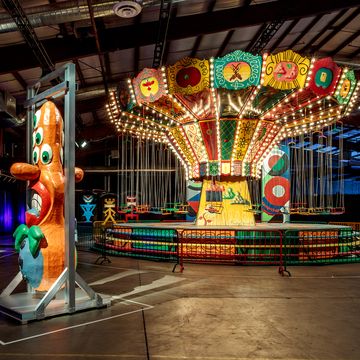I was eight years old when I had my first sip of Bordeaux, a quick gulp stolen from my father's glass. I had gone with my parents to the opening of an exhibition of Château Mouton Rothschild's famous "artist labels" at the Oklahoma City Museum of Art, where my mother was a volunteer. Baroness Philippine de Rothschild had flown all the way from France for the occasion, and though I clearly preferred my plastic cup of Dr Pepper to her wine, she was very sweet with me. Somewhere in my family's photo albums is a picture of the two of us from that night. The baroness looks radiant in a silk shift and frosted pink lipstick; I am sporting an excruciatingly bad perm and have a gap between my front teeth. We are both beaming for the camera.
My parents took me to Paris two years later, for my fourth-grade spring break. Coming from Oklahoma City, with its open spaces and urban sprawl, I was a little hesitant at first: the streets in the Latin Quarter seemed strangely small and narrow, as though I were looking through the wrong end of a pair of binoculars. But after a few days and a few pains au chocolat, I was hooked. I returned to Paris to study during my junior year of college, and I went back again after graduation to work for a year in a French public school. I ate baguettes and aged cheeses, tried my hand at the fine art of flânerie and had my heart stomped upon, as every American woman in Paris must, by some dashingly handsome men. More so than any school, Paris was my education; better than any guidance counselor, it set my priorities straight. A handful of years ago, in the middle of a Ph.D. program in anthropology, I went there on a research trip, and one night, high on butterfat and many bottles of wine, decided to ditch academia and become a food writer instead. I even fell in love with my husband, Brandon, because of Paris: he had lived there, too, and wooed me with memories of macarons and the scent of flaming Calvados on crêpes.
I am forever indebted to that city. But I never forgot what started the ball rolling in the first place: that sip of Bordeaux. If it weren't for the baroness, who knows where I would be?
It's hard not to be wowed by Bordeaux, especially if you see it for the first time in the early fall, as Brandon and I did last year, arriving from the east and wending our way toward the Pont de Pierre, the nearly 200-year-old stone bridge that spans the river Garonne and connects the city's halves. Under ornate three-armed streetlamps, bicycles rolled leisurely along our route, carrying their riders home from work.
For city dwellers, the Bordelais, as they are called, seemed surprisingly casual, their ties loosened and light sweaters looped around their shoulders. Looking past them to the opposite shore, I could see the manicured waterfront freckled with people out for an evening stroll. Straight ahead, a ribbon of stately buildings unfurled along the river's curve, announcing the heart of the city. The sun was starting its descent, crowning the symmetrical facades with a halo of gold.
Eager to escape the evening traffic, we headed straight for our hotel, on the Place de la Comédie, a lively central square flanked by the neoclassical Grand Théâtre and the Regent Grand Hotel Bordeaux. Thanks to an extensive renovation, the historic hotel is now a full-scale urban resort, with 150 guest rooms, two restaurants, a soon-to-open spa and even a high-fashion shopping arcade -- all decorated by the illustrious French designer Jacques Garcia. Our room was lush, eye-catching and impeccably conceived in jewel-toned fabrics and gleaming wood. I felt as if I'd stepped into a fancy French pastry, the kind with a lacquered top and glazed fruits around the base, almost too pretty to eat.
Founded in the 3rd century B.C. by a Gallic tribe that called it Burdigala, Bordeaux grew to be the largest port in the country by the turn of the 18th century. But the years that followed were not particularly kind. As the city expanded and industrialized, its churches and monuments became blackened with soot and grime; its quays, cluttered with warehouses and frequented by prostitutes. For decades Bordeaux, in France's southwestern corner, was thought of as a dingy city, dwelling in the shadow of Paris, its glitzy sister to the north. But in 1995 the Bordelais elected an indefatigable new mayor, former prime minister Alain Juppé, who set to work reawakening the city and its civic pride. Limestone buildings were scrubbed back to their original pale-yellow splendor; waterfront warehouses were demolished and replaced with a landscaped promenade; a sleek electric tramway was commissioned to link the city's neighborhoods. Today, with its brilliance restored and then some, Bordeaux holds a coveted slot as a UNESCO World Heritage site.
The city is eminently walkable, with most of its prized historic districts clustered in a central, car-free zone. Having lived in Paris during a subway strike and having consequently stumbled across many hidden gems while running errands pied, I'm a strong proponent of getting to know new places on foot. From our first day in Bordeaux, Brandon and I spent much of our time roaming city blocks in search of pastry shops and corner bistros. Everywhere we went, we were struck by the happy jumble of eras: medieval cathedrals sit side by side with neoclassical columns and (refreshingly tasteful) new construction. While Bordeaux may be in the midst of a dramatic modern rebirth, everyday life on the streets goes on as it has for centuries. Turning onto the Rue des Faures, a slender market street where the scent of mint hung overhead like a benevolent cloud, we found ourselves caught up in a crowd of old women shuffling down the sidewalk with empty shopping caddies. We emerged at the foot of the 15th-century St.-Michel Basilica, in the middle of the Saturday market. The stands overflowed with peppers of all sizes, eggplants, peaches, live chickens and rabbits, cheeses and early apples. While Brandon and I could easily have bought one of everything, we decided to save our appetites for dinner.
The restaurant at Château Cordeillan-Bages, north of the city in Pauillac, embodies the ambitions of 21st-century Bordeaux better than any other. Chef Thierry Marx has earned two Michelin stars for his radically innovative food; though we were initially skeptical -- thinking back to a prior unsettling experience with so-called molecular cuisine -- we need not have worried. Marx, who looks a bit like Bruce Willis, is more interested in pleasure than in pure shock value. The napoleon of foie gras, chocolate and passion-fruit gelée was stunningly delicious; so was the "risotto" of bean sprouts cut to the size of grains of rice, presented in a foamy broth flavored with oysters, porcini mushrooms, white wine and shallots, and topped with a single slice of black Périgord truffle.
Later in our trip, however, I was equally smitten with a restaurant at the opposite end of the style spectrum. I spent a year of college living with a host mother who cooked a lot of cassoulet, and so I have a soft spot for hearty, traditional French food. In Bordeaux I discovered my Mecca: La Tupina, owned by Jean-Pierre Xiradakis, who could power the entire city on charisma alone.
Xiradakis was only twenty-three when he opened his small restaurant, which is built around an old-fashioned hearth and specializes in the region's earthy, humble cuisine. He started out as a one-man show: cooking, serving and, at the end of each night, sweeping the floor. Today, forty-one years and a significant expansion later, La Tupina is still centered on that same hearth. I can't think of a more delicious lunch than the one Brandon and I shared: a thick slab of country pâté; skillets of chanterelles and orange-yolked eggs; potatoes fried in duck fat; slices of local tomatoes topped with a slurry of oil, vinegar, cornichons, parsley and grated hard-boiled eggs. As I looked around the bustling dining room, I realized that this was where the real Bordeaux could be found: at the table, talking with its mouth full, gesturing with its hands, savoring and relishing.
The more we saw of Bordeaux, the more it became clear that while the French may be famous for celebrating the sensual pleasures of daily life, the Bordelais bring a particularly sunny quality to this pursuit, approaching both work and play with contagious gusto. When Jean d'Alos, owner of the renowned Bordeaux cheese shop that bears his name, decided to carry Parmigiano-Reggiano for the first time, he devoted three years to selecting the best producer. One afternoon, while Brandon and I browsed in the bric-a-brac shops along the Rue Nôtre-Dame, a young man on a motorcycle overheard us speaking English and asked where we were from. Ten minutes later he had given us half a dozen recommendations for local restaurants.
Of course, nowhere is the passion of the Bordelais more evident than in their signature industry: wine. Blessed with a temperate climate, Bordeaux has been a prime site for grape cultivation for almost 2,000 years, since the conquering Romans planted the first vines on the banks of the Garonne and the Dordogne. The area is now home to 11,000 winegrowers, and while a few are large, flashy enterprises, most are intimate family operations. To get a sense of what that means, we drove forty-five minutes east to St.-Émilion, a medieval wine-producing village along the Dordogne.
After settling into Maison des Cordeliers, a limestone villa tucked amid the grapevines, we set out for Château Gueyrosse, a small vineyard run by Samuelle Delol, a sixth-generation winemaker. Though it was early in the day when we arrived, her father, Yves, was already waiting for us outside, dressed in a striped crewneck and matching cardigan. The sky threatened rain as he and Samuelle gave us a tour of the property. The septuagenarian Yves pointed to a second-story window in the family house; above his scruffy beard, his eyes were bright.
"See that?" he said proudly. "That's the room where I was born."
Like many growers in the area, the Delols have worked the same plot for more than a century. In the wake of the French Revolution, local land was divided into small parcels and sold to individual families, many of whom still tend it themselves. With a small staff, Samuelle oversees thirty-nine acres of vines, using only natural, herbicide-free methods, the way Yves's grandfather taught him. While we drank a bottle of the soft, supple 1988 vintage, Yves regaled us with stories about past harvests, recalling the frost of 1956 and the way it split the vines straight through their cores.
Making wine in Bordeaux may be a family affair, but as the city reinvents itself, so too does the industry. A new winemaking model has recently arisen, the brainchild of businessman Bernard Magrez. Magrez owns twenty-one vineyards in Bordeaux -- plus another fourteen around the world -- and from them has produced his own global brand of reasonably priced premium wines, an arrangement previously untried in this region, where tradition and modest capital have kept most operations small. But even as Magrez upends the established business model, he remains loyal to time-honored Bordeaux winemaking methods, seeing to it that each grape is picked by hand.
It would be interesting, I thought, to ask my old pal the baroness about these new developments. But when I called Château Mouton Rothschild, explaining that I had met her as a child all those years ago in Oklahoma City, I was told she was booked. We would have to come back another time, the voice on the end of the line announced. I didn't think that would be a problem. We had barely scratched the surface of Bordeaux, but what we'd found was inspiring. The workers who scoured the city's blackened facades must have felt the same way when they saw the first glimmers of golden limestone beneath the soot: a sense of discovery, possibility and pride. If I could hold on to that feeling, I thought to myself, it might tide me over until our next visit. Failing that, the bottles of wine in my suitcase would do just fine.
Native Intelligence: Bordeaux
WHEN TO GO
The climate in Bordeaux is fairly mild across the seasons, but in the late summer and early fall, just before the harvest, the city comes into full bloom, with temperatures hovering in the sixties and seventies. However, avoid harvest time itself, which usually falls around the third week of September, since vintners may be too busy to welcome visitors.
GETTING THERE
Bordeaux-Mérignac Airport connects the city to a number of European hubs. (Our flight was an easy ninety minutes from Amsterdam.) Arriving by train is another option: the TGV from Paris takes only three hours.
GETTING AROUND
Pedestrian-only streets make up much of the town center; it's a safe and pleasant place to wander. If your feet get tired, hop on the new tramway. For visiting the neighboring villages and vineyards, a rental car is your best bet.
WHERE TO STAY
Regent Grand Hotel Bordeaux Doubles from $580.2-5 Place de la Comédie; 800-545-4000; regenthotels.com.
Château Valandraud Just a few minutes outside St.-Émilion, this six-bedroom guesthouse is attached to the château's limestone chais, where the wine is stored in barrels before being bottled. Decorated largely in white and trimmed with blond wood, the interior feels both minimal and warm, a tranquil hideaway from the bustle of the city. From $13,400 a week, for one party of up to twelve guests. For reservations, contact HomesAway, 800-374-6637; homesaway.com.
Maison des Cordeliers This limestone house, a two-minute walk from the center of St.-Émilion, is an ideal home base for a family vacation or a week of wine tasting with friends. It looks from the outside like a traditional Bordeaux villa, but inside it's ingeniously modern, with a large central area left open to the rafters, black granite counters in the kitchen, and four elegant bedrooms. From $16,200 per week, for one party of up to eight guests.For reservations, contact HomesAway, 800-374-6637; homesaway.com.
WHERE TO EAT
Restaurant Jean-Marie Amat At the end of a narrow street, adjacent to a lumpy gravel parking lot, the newest venture of star Bordeaux chef Jean-Marie Amat is tricky to find, but don't let that dissuade you. In a smart, hypermodern space grafted onto the gutted Château du Prince Noir, the restaurant is a stellar surprise: order the roasted lobster with whole cloves of garlic and the croustade aux pommes, a sort of tarte Tatin encased in buttery pastry. 26 Rue Raymond Lis, Lormont; 011-33-5-56-06-12-52.
Château Cordeillan-Bages Route des Châteaux, Pauillac; 011-33-5-56-59-24-24; cordeillanbages.com. Closed mid-December through mid-February.
La Tupina6 Rue Porte de la Monnaie; 011-33-5-56-91-56-37; latupina.com.
L'Envers du Décor In St.-Émilion, follow the locals here. This convivial wine bar and bistro serves market-fresh fare (tomato salads, fried eggs with piperade and ham). 11 Rue du Clocher; 011-33-5-57-74-48-31.
Pâtisserie Antoine The canelé, a custardy treat, is Bordeaux's most famous pastry. In a city full of them, Antoine's was the winner. 19 Cours Portal; 011-33-5-56-81-43-19.
WHAT TO DO
Nearly every block in Bordeaux offers something to draw the eye, whether it's one of the city's medieval gates (the Porte Cailhau is my favorite), the imposing facade of the Grand Théâtre or the brand-new water mirror, which reflects the buildings of the majestic Place de la Bourse. The visitors' bureau offers a worthwhile guided walking tour at 10:00 A.M. daily, peppered with local lore, history and notes on architecture. For reservations, contact the Bordeaux tourism office, 12 Cours du XXX Juillet; 011-33-5-56-00-66-00; bordeaux-tourisme.com.
In just two hours at the école du Vin de Bordeaux, you'll learn how to read the label of a French wine and how to decipher a wine's bouquet. You may also learn that your sense of smell could use some refining. 3 Cours du XXX Juillet; 011-33-5-56-00-22-85; bordeaux.com/ecole-du-vin.
To see some of the region's most prestigious châteaus, head north on Route D2, into the Médoc. But don't miss the smaller holdings to the east, in St.-Émilion and the surrounding villages. (Wherever you go, call ahead to make an appointment.)
Château Quercy Stéphane Apelbaum presses grapes the old-fashioned way, with a wooden paddle -- or his feet. 3 Grave-Vignonet, Vignonet; 011-33-5-57-84-56-07; chateauquercy.com.
Château Gueyrosse24 Chemin de Gueyrosse, Libourne; 011-33-5-57-51-02-63; gueyrosse@free.fr.
WHERE TO SHOP
The triangle formed by the Cours Clemenceau, the Allées de Tourny and the Cours de l'Intendance is home to many of Bordeaux's finest shops, from the tony children's classic Bonpoint to Sonya Rykiel and Robert Clergerie.
If your tastes run to antiques, a stroll along the Rue Nôtre-Dame is in order. This quiet street in the Chartrons quarter is lined with shops selling everything from antique lace to gilt-edged mirrors. Another notable spot is Les Hangars du Passage (12-14 Rue des Allamandiers; 011-33-5-56-91-38-43), an antiques co-op behind the St.-Michel Basilica.
For wonderful cheese, be sure to visit Jean d'Alos (4 Rue Montesquieu; 011-33-5-56-44-29-66).


